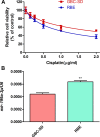MiR-199a-3p enhances cisplatin sensitivity of cholangiocarcinoma cells by inhibiting mTOR signaling pathway and expression of MDR1
- PMID: 28422725
- PMCID: PMC5464895
- DOI: 10.18632/oncotarget.16834
MiR-199a-3p enhances cisplatin sensitivity of cholangiocarcinoma cells by inhibiting mTOR signaling pathway and expression of MDR1
Abstract
Several studies have reported reduced miRNA-199a-3p (miR-199a-3p) in different human malignancies, however, little is known about miR-199a-3p in cholangiocarcinoma cells. In this study, we demonstrate the essential role and mechanism of miR-199a-3p in regulating cisplatin sensitivity in cholangiocarcinoma cell lines. Using a CCK-8 cell counting assay we found that expression of miR-199a-3p was positively correlated with cisplatin sensitivity in cholangiocarcinoma cell lines. MiR-199a-3p overexpression could decrease the proliferation rate and increase apoptosis of cholangiocarcinoma cells in the presence of cisplatin, while miR-199a-3p inhibition had the opposite effect. Further study demonstrated that mTOR was the target gene of miR-199a-3p, and that miR-199a-3p mimics could inhibit expression of mTOR, which consequently reduced the phosphorylation of its downstream proteins 4EBP1 and p70s6k. Rescue experiments proved that miR-199a-3p could increase the cisplatin sensitivity of cholangiocarcinoma cell lines by regulating mTOR expression. Moreover, we also found that miR-199a-3p overexpression could reduce cisplatin induced MDR1 expression by decreasing the synthesis and increasing the degradation of MDR1, thus enhancing the effectiveness of cisplatin in cholangiocarcinoma. In conclusion, miR-199a-3p could increase cisplatin sensitivity of cholangiocarcinoma cell lines by inhibiting the activity of the mTOR signaling pathway and decreasing the expression of MDR1.
Keywords: MDR1; MiR-199a-3p; chemosensitivity; cholangiocarcinoma; mTOR.
Conflict of interest statement
The authors declare no conflicts of interest.
Figures






Similar articles
-
p53 induces miR-199a-3p to suppress mechanistic target of rapamycin activation in cisplatin-induced acute kidney injury.J Cell Biochem. 2019 Oct;120(10):17625-17634. doi: 10.1002/jcb.29030. Epub 2019 May 30. J Cell Biochem. 2019. PMID: 31148231
-
MiR-199a-3p enhances breast cancer cell sensitivity to cisplatin by downregulating TFAM (TFAM).Biomed Pharmacother. 2017 Apr;88:507-514. doi: 10.1016/j.biopha.2017.01.058. Epub 2017 Jan 23. Biomed Pharmacother. 2017. PMID: 28126676
-
miR-199a-3p enhances cisplatin sensitivity of ovarian cancer cells by targeting ITGB8.Oncol Rep. 2018 Apr;39(4):1649-1657. doi: 10.3892/or.2018.6259. Epub 2018 Feb 12. Oncol Rep. 2018. PMID: 29436681 Free PMC article.
-
miR-199a: A Tumor Suppressor with Noncoding RNA Network and Therapeutic Candidate in Lung Cancer.Int J Mol Sci. 2022 Jul 31;23(15):8518. doi: 10.3390/ijms23158518. Int J Mol Sci. 2022. PMID: 35955652 Free PMC article. Review.
-
Chemoresistance and chemosensitization in cholangiocarcinoma.Biochim Biophys Acta Mol Basis Dis. 2018 Apr;1864(4 Pt B):1444-1453. doi: 10.1016/j.bbadis.2017.06.005. Epub 2017 Jul 7. Biochim Biophys Acta Mol Basis Dis. 2018. PMID: 28600147 Review.
Cited by
-
MicroRNA-33a-5p overexpression sensitizes triple-negative breast cancer to doxorubicin by inhibiting eIF5A2 and epithelial-mesenchymal transition.Oncol Lett. 2019 Dec;18(6):5986-5994. doi: 10.3892/ol.2019.10984. Epub 2019 Oct 14. Oncol Lett. 2019. PMID: 31788073 Free PMC article.
-
MicroRNAs: immune modulators in cancer immunotherapy.Immunother Adv. 2021 May 13;1(1):ltab006. doi: 10.1093/immadv/ltab006. eCollection 2021 Jan. Immunother Adv. 2021. PMID: 35919742 Free PMC article. Review.
-
MicroRNA-Based Combinatorial Cancer Therapy: Effects of MicroRNAs on the Efficacy of Anti-Cancer Therapies.Cells. 2019 Dec 20;9(1):29. doi: 10.3390/cells9010029. Cells. 2019. PMID: 31861937 Free PMC article. Review.
-
Mutant p53 promotes RCP-dependent chemoresistance coinciding with increased delivery of P-glycoprotein to the plasma membrane.Cell Death Dis. 2021 Feb 24;12(2):207. doi: 10.1038/s41419-021-03497-y. Cell Death Dis. 2021. PMID: 33627632 Free PMC article.
-
mTOR Inhibitors in Advanced Biliary Tract Cancers.Int J Mol Sci. 2019 Jan 24;20(3):500. doi: 10.3390/ijms20030500. Int J Mol Sci. 2019. PMID: 30682771 Free PMC article. Review.
References
-
- Siegel R, Naishadham D, Jemal A. Cancer statistics, 2013. CA Cancer J Clin. 2013;63:11–30. - PubMed
-
- Nathan H, Pawlik TM, Wolfgang CL, Choti MA, Cameron JL, Schulick RD. Trends in survival after surgery for cholangiocarcinoma: a 30-year population-based SEER database analysis. Journal of Gastrointestinal Surgery. 2007;11:1488–1497. - PubMed
-
- Valle JW, Furuse J, Jitlal M, Beare S, Mizuno N, Wasan H, Bridgewater J, Okusaka T. Cisplatin and gemcitabine for advanced biliary tract cancer: a meta-analysis of two randomised trials. Ann Oncol. 2014;25:391–398. - PubMed
MeSH terms
Substances
LinkOut - more resources
Full Text Sources
Other Literature Sources
Medical
Miscellaneous

